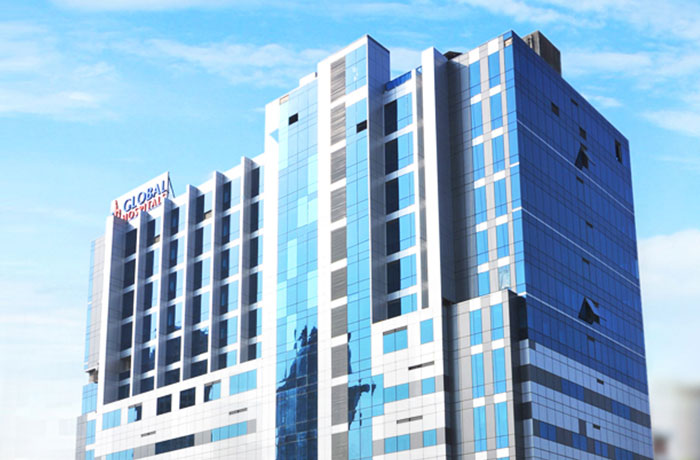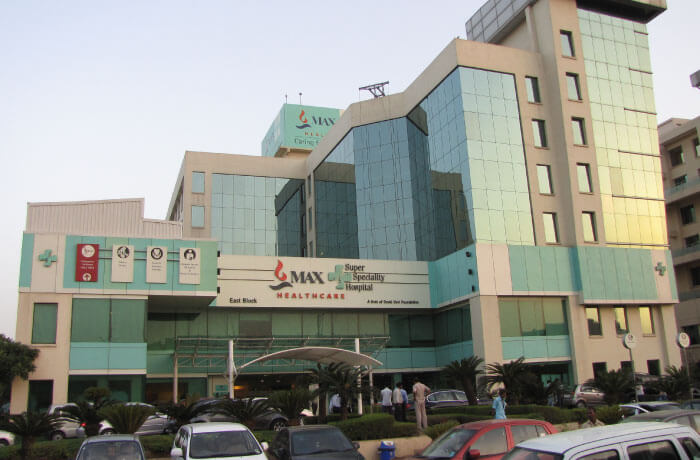Cardiology
Coronary Artery Bypass Graft Treatment
Bypass Surgery
Coronary artery disease is a narrowing of the coronary arteries (blood vessels that supply the heart muscle with oxygen). It reduces the blood supply to the heart muscle, leading to angina and heart attacks.
What is Coronary Artery By-pass Grafting (CABG)?
Coronary Artery Bypass Graft surgery (CABG) is a kind of surgical procedure that is used to treat coronary artery disease (CAD). In CAD, a waxy substance known as plaque builds up
inside the blood vessels that supplies oxygen and nutrients to the heart muscles which leads to narrowing of the coronary arteries. During this
procedure, the doctor surgically connects a healthy blood vessel from leg, arm or chest to the heart and creates a new pathway around the blocked or partially blocked
artery to restore the blood flow.
What are the benefits of surgery?
The benefits of the coronary artery bypass surgery include:
• Reduces CHD symptoms.
• Improves pumping ability of the heart.
• Reduced risk of heart attack.
• Person is able to resume an active lifestyle.
What is coronary artery disease?
Coronary artery disease is the narrowing of the coronary arteries (blood vessels which supplies the heart muscle with oxygen). It reduces the blood supply to the heart muscle,
which may lead to angina and heart attacks.
Causes of coronary artery disease
The most common cause of coronary artery disease is vascular injury with cholesterol plaque build-up in the arteries, also known as atherosclerosis. Reduced blood flow occurs when
one or more than one of these arteries becomes partially or completely blocked.
The four primary coronary arteries which are located on the surface of the heart:
• Right main coronary artery.
• Left main coronary artery.
• Left circumflex artery.
• Left anterior descending artery.
These arteries bring oxygen as well as nutrient-rich blood to your heart. A heart is a muscle which is responsible for pumping blood throughout human body. According to the Cleveland
Clinic, a healthy heart pumps approximately 3,000 gallons of blood through a body every day. Like any other organ or muscle, the heart must receive an adequate, dependable
supply of blood in order to carry out its work. Reduced blood flow to the heart can cause symptoms of Coronary Artery Disease. Other rare causes of damage or blockage to a coronary
artery also limits the blood flow to heart.
Also read :- Best Cancer Hospitals in India
Who Needs Coronary Artery Bypass Grafting?
Coronary artery bypass grafting (CABG) is used to treat people who have severe coronary heart disease that could lead to a heart attack. CABG also may be used to treat people
who have heart damage followed by a heart attack but still have blocked arteries. Your doctor may recommend CABG if other treatments, such as lifestyle change or medicine, aren't
working. He or she may also recommend CABG if you have severe blockages in the large coronary arteries that supply a major part of the heart muscle with blood, especially, if
your heart's pumping action has already been weakened. CABG may also be a treatment option if you have blockage in the heart that are not been be treated with angioplasty.
Your doctor will decide whether you should have CABG or not based on a number of factors, including:
• The presence and also severity of CHD symptoms.
• The severity and the location of blockages in the coronary arteries.
• Response to other treatments.
• Quality of life.
• Any other medical problems.
CABG may be done in an emergency case , such as during a heart attack.
What does the operation involve?
• The doctor will insert an intravenous (IV) line into the arm or hand. A device called, catheter, will be put in neck and the wrist to monitor the heart and blood pressure
• The anesthesiologist will continuously monitor the heart rate, blood pressure, breathing, and blood oxygen level during the surgery. Once you are sedated (put into a deep sleep),
a breathing tube will be inserted into throat and will be connected to a ventilator.
• The doctor will make a long incision in chest and divide the sternum (breastbone) in half, lengthwise to expose the heart.
• Once the chest is opened, the heart will be temporarily be stopped by the doctor and a heart-lung machine will be used to circulate blood in the body.
• The surgeon will then take a section of a healthy blood vessel from inside of chest wall (the internal mammary artery) or from lower leg, and will connect the ends around the
blocked artery to divert the flow of blood.
What complications can happen?
Although complications from coronary artery bypass grafting (CABG) are uncommon, the risks may include:
• Wound infection.
• Bleeding
• Reaction to anesthesia.
• Fever.
• Pain.
• Stroke, heart attack, or even death.
A few patients develop a fever associated with chest pain, irritability, and decreased appetite. This is because of inflammation involving the lung and heart sac. This complication
sometimes is seen from 1 to 6 weeks after surgeries that involve cutting through the outer covering of the heart. This reaction usually is very mild. However, some patients
may even develop fluid build-up around the heart that requires treatment. Memory loss and other similar changes, such as problems while concentrating or thinking clearly, may occur
in some people.These changes are more likely to occur in people who are older, or who have high blood pressure or lung disease, who drink excessive amount of alcohol. These side
effects are often improved after several months of surgery. Use of a heart-lung bypass machine also increases the risk of blood clots forming in the blood vessels. Clots can travel
to brain or other parts of body and may even block the flow of blood, which may cause a stroke or other issues. But Recent technical improvements in heart-lung bypass machines are
helping to reduce the risk of blood clots forming.
Are there any alternatives to surgery?
For few people it is possible to have a percutaneous coronary intervention to widen or unblock an artery using a small inflatable balloon. Medication can also be used to
relieve the symptoms of coronary artery disease.
How soon will I recover?
After the operation patient will be transferred to the cardiac intensive-care unit or high-dependency unit for a few days, and then to the ward. You should be able to go home within
7 to 10 days. The healthcare team will tell you when the patient can return to normal activities. Regular exercises may help you to return to normal activities sooner. Most people
make a good recovery, with relief from angina, but symptoms can sometimes show up.
Heart bypass surgery, or coronary artery bypass grafting, is a treatment that opens clogged heart arteries to restore blood flow to parts of the heart that aren't receiving enough oxygen.When blood flow is interrupted by an artery blockage, heart attacks or symptoms similar to heart attacks may result. By creating a diversion around obstructions with blood vessels from other parts of your body, CABG restores blood flow.
Why is Coronary artery bypass surgery done?
Patients with severe Coronary Heart Disease (CHD), also known as Coronary Artery Disease, are treated with Coronary Artery Bypass Grafting (CABG). It is applied to enhance the heart's blood flow. The purpose of the heart arteries is to provide your heart with oxygen-rich blood. In coronary heart disease, a buildup of plaque (a mixture of fat, cholesterol, calcium, and other substances) gets accumulated in the arteries causing them to become blocked.
In CABG, the regular blood flow to the heart is restored by bypassing the blocked arteries with a blood vessel graft. The goal of CABG is to enhance the blood supply to the heart muscle by creating a new pathway and rerouting blood flow around blocked arteries.
Symptoms of Coronary Heart Disease (CHD) may include:
- Abnormal heart rhythms
- Chest pain
- Palpitations
- Swelling in the hands and feet
- Fatigue (severe tiredness)
- Shortness of breath
- Indigestion
Coronary artery bypass graft indications
- Obstruction of the left major coronary artery. The heart muscle receives a large amount of blood from this artery.
- Severe chest discomfort brought on by constriction of several cardiac arteries.
- A clogged coronary artery that is unresponsive to coronary angioplasty treatment.
- An unsuccessful angioplasty, either with or without a stent. For example: A narrowed artery after stenting.
Diagnostic tests before Coronary artery bypass surgery
You will have diagnostic testing and investigations done before the procedure, including:
- Complete Blood Count (CBC)
- Thromboplastin time (PTT) and prothrombin time (PT)
- Chest X-ray
- Cardiac Catheterization
- ECG or EKG
- Exercise stress test
- Nuclear cardiac stress test
- Kidney and liver function tests
- X-ray angiography or computed tomography (CT) scan angiography.
Coronary artery Bypass Grafting: Before, during and after
Before
- You will get an opportunity to ask any questions you may have regarding the process and the surgeon will go over every detail with you prior to the surgery.
- You will be advised to fast for eight hours prior to the treatment, usually after midnight.
- Inform your physician of any possible pregnancy as well as any dietary sensitivities or allergies, including those to latex, tape, iodine, and anesthesia (local and general).
- Inform your physician about all of the medications you use, including vitamins, herbs, and supplements.
- Inform your doctor if you have a history of bleeding problems or if you take aspirin, blood thinners, or any other medications that affect blood coagulation. You may be asked to cease some of these drugs prior to the surgery.
During the surgery
Blood vessel harvesting
- Surgery for a coronary artery bypass graft typically takes three to six hours.
- However, the number of blood vessels being joined may determine how long it takes.
- Blood arteries can be extracted from the radial artery in your arm, the internal artery in your breast, or the sapphire vein in your leg.
- In CABG, the regular blood flow to the heart is restored by bypassing the blocked arteries with a blood vessel graft.
- Using the blood vessel as a graft, a bypass (detour) around the obstruction is created by taking a blood vessel from another area of your body, such as your leg, arm, or chest.
- In cases where there are several blocked arteries, multiple bypasses might be necessary. These bypasses are triple (3), double (2), and quadruple (4) in nature.
- Arteries from the chest are preferred by surgeons because they do not constrict over time like blood vessels from the leg or arm.
Surgical procedure
- Once all the graft vessels have been removed, the heart surgeon will make a long cut in the center of your chest and open the rib cage.
- During the treatment, your heart will be momentarily stopped, but your body will still be able to pump blood with the help of a heart-lung machine.
- The surgeon will use the extracted blood vessel to create the bypass once they get access to your heart.
- Just after your blood leaves your heart, the upper end of the bypass is connected to your aorta, the big artery that distributes blood throughout your body.
- Beyond the obstruction, the lower end of the bypass will be connected to the clogged artery.
- Your heart will be restarted with carefully calibrated electrical shocks once the grafts are placed, allowing blood to flow to your newly implanted heart.
- Using stitches and staples, the surgeon will eventually close the incision and the rib cage.
Types of Coronary artery Bypass Grafting
Even though most patients receiving CABG use the same strategies, there are situations in which different approaches are more suited for your specific situation. This process comes in multiple varieties:
- Traditional CABG: Under general anesthesia, the patient undergoes an open cardiac surgery in which the surgeon makes a 6–8 inch incision in the sternum to access the patient's heart. The patient's heart is then stopped, and the patient is placed on a heart–lung bypass machine. After harvesting a suitable vessel, the surgeon places a graft over the blocked coronary artery.
- Off pump CABG: The procedure for this surgery is comparable to that of a conventional bypass. Instead of using a bypass machine, the patient receives medication to decrease their heartbeat and gets a graft placed in their working heart. A common term for off-pump CABG is "beating heart bypass surgery."
- Totally Endoscopic Robotically Assisted Coronary Artery Bypass (TECAB): This is the most advanced method of CABG. Instead of opening the chest, a 3-inch incision is made, allowing the inside of the chest to be seen on a monitor while the graft is implanted.
Robotic coronary artery bypass Surgery
- This technique is also known as keyhole surgery or totally endoscopic robotically assisted CABG.
- It is the most advanced procedure in heart surgery.
- In this treatment, the physician performs CABG surgery with the aid of surgical robots.
- To carry out the surgery, the surgeon drives the robotic arms, controls the robot's movements.
- The robotic arms are equipped with an endoscope that allows the surgeon to see into the body and see the surgical results on a screen.
- In a TECAB grafting operation, rather than creating a big incision to open the sternum and rib cage, the surgeon makes tiny incisions and accesses the heart through the spaces between some of the ribs.
Coronary artery bypass recovery time
- The total recovery following traditional bypass surgery requires 6-12 weeks.
- The recovery period is less in the other two CABG.
- After recovering from CABG surgery, the majority of patients report feeling better. Specific instructions for your recuperation and the timeline for going back to your regular job will be provided by your doctor.
- He or she will provide you detailed advice on how to maintain your overall health following CABG surgery as well as how to care for your incision.
Factors affecting the cost of Coronary artery Bypass Grafting In India
The following is a summary of some of the variables influencing CABG costs in India.
- Type of technique
- Hospital and its infrastructure
- Expertise of the cardiac surgeon
- Diagnostic tests
- Duration of stay
Why choose India for CABG?
The majority of hospitals in India that perform heart surgeries have state-of-the-art infrastructure and are properly furnished with the newest medical equipment. The surgeons at these clinics are highly trained and experienced, and they give their patients the best possible care. In addition to having some of the greatest cardiologists and cardiac specialists in the world at their disposal, the low cost benefit that patients receive in India is crucial.
Best hospitals for CABG in India
- Fortis Memorial Research Institute, Gurgaon
- Fortis Escorts Hospital, New Delhi
- Medanta The Medicity, Gurugram
- Artemis Hospital, Gurugram
- Max Hospital, Delhi
- MGM Healthcare, Tamil Nadu
- Narayana Multispeciality Hospital, Bangalore
- Indraprastha Apollo Hospital, New Delhi
Best doctors for CABG in India
- Dr. Udgeath Dhir
- Dr. Z S Meharwal
- Dr Naresh Theran
- Dr. Anil Bhan
- Dr. Sushant Srivastava
- Dr Rajneesh Malhotra
- Dr. K. R Balakrishnan
- Dr. Devi Prasad Shetty
- Dr. Anoop K Ganjoo
TREATMENT-RELATED QUESTIONS
GetWellGo will provide you end-to-end guidance and assistance and that will include finding relevant and the best doctors for you in India.
A relationship manager from GetWellGo will be assigned to you who will prepare your case, share with multiple doctors and hospitals and get back to you with a treatment plan, cost of treatment and other useful information. The relationship manager will take care of all details related to your visit and successful return & recovery.
Yes, if you wish GetWellGo can assist you in getting your appointments fixed with multiple doctors and hospitals, which will assist you in getting the second opinion and will help you in cost comparison as well.
Yes, our professional medical team will help you in getting the estimated cost for the treatment. The cost as you may be aware depends on the medical condition, the choice of treatment, the type of room opted for etc. All your medical history and essential treatment details would be analyzed by the team of experts in the hospitals. They will also provide you with the various types of rooms/accommodation packages available and you have to make the selection. Charges are likely to vary by the type of room you take.
You have to check with your health insurance provider for the details.
The price that you get from GetWellGo is directly from the hospital, it is also discounted and lowest possible in most cases. We help you in getting the best price possible.
No, we don't charge patients for any service or convenience fee. All healthcare services GetWellGo provide are free of cost.
Top Doctors for Cardiology
Top Hospitals for Cardiology
Contact Us Now!
Fill the form below to get in touch with our experts.

.jpg)





